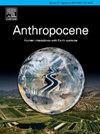南极海域乔治王岛菲尔德斯半岛湖泊人为影响的沉积指标
IF 3.3
2区 地球科学
Q2 ENVIRONMENTAL SCIENCES
引用次数: 0
摘要
位于乔治国王岛上的菲尔德斯半岛是南极人类活动最激烈的地点之一,位于受全球变暖影响强烈的地区。虽然已经注意到其曾经原始环境的变化,但缺乏有关人类增加之前该地区自然状态的数据(~ 1968)。本文以菲尔德斯半岛的7个湖泊为研究对象,采用自上而下的方法研究了人类活动前和人类活动后的沉积物,以评估人类活动对湖泊生态过程的影响。我们利用16S rRNA元条形码、高效液相色谱(HPLC)色素和沉积物金属分析来研究细菌和浮游植物群落的差异。我们观察到人类活动前和人类活动后样本中细菌群落的湖泊特异性差异。通过指示种分析,我们在两个湖泊的后人类活动沉积物中发现了与污染环境相关的细菌(如KD4-96, Bacteroidetes vadinHA17, Hungateiclostridiaceae和Leptolinea),金属含量显著增加。由于这两个湖都非常靠近道路和机场基础设施,这些关联可能意味着包括石油衍生物在内的化合物最近更大的存在。结果表明细菌DNA保存良好,但成岩过程可能影响了色素浓度。我们的数据表明,细菌DNA可以作为沉积代用物来重建环境变化,包括南极湖泊的人为影响。本文章由计算机程序翻译,如有差异,请以英文原文为准。
Sedimentary indicators of anthropogenic impact in Fildes Peninsula lakes (King George Island, Maritime Antarctica)
Fildes Peninsula, on King George Island, is among the Antarctic sites with the most intense human activity and is located in a region strongly influenced by global warming. While alterations to its once pristine environments have been noted, there is a lack of data concerning the region’s natural state before the increased human presence (∼1968). We studied seven lakes from Fildes Peninsula to assess anthropogenic effects on their ecological processes by studying pre- and post-anthropic sediments with a top-bottom approach. We examined differences in bacterial and phytoplankton communities using 16S rRNA metabarcoding, HPLC (high performance liquid chromatography) pigments and analysis of sediment metals. We observed lake-specific differences in bacterial communities between pre- and post-anthropic samples. Using indicator species analysis, we identified bacteria associated with polluted environments (e.g., KD4–96, Bacteroidetes vadinHA17, Hungateiclostridiaceae and Leptolinea) in post-anthropic sediments from two lakes that showed notable increases of metals. As both lakes are very close to roads and airport infrastructure, these associations may imply the greater recent presence of compounds including petroleum derivatives. Results indicated good preservation of bacterial DNA, but also that diagenetic processes may have affected pigment concentrations. Our data suggest that bacterial DNA may be used as a sedimentary proxy to reconstruct environmental changes including anthropogenic impacts in Antarctic lakes.
求助全文
通过发布文献求助,成功后即可免费获取论文全文。
去求助
来源期刊

Anthropocene
Earth and Planetary Sciences-Earth and Planetary Sciences (miscellaneous)
CiteScore
6.30
自引率
0.00%
发文量
27
审稿时长
102 days
期刊介绍:
Anthropocene is an interdisciplinary journal that publishes peer-reviewed works addressing the nature, scale, and extent of interactions that people have with Earth processes and systems. The scope of the journal includes the significance of human activities in altering Earth’s landscapes, oceans, the atmosphere, cryosphere, and ecosystems over a range of time and space scales - from global phenomena over geologic eras to single isolated events - including the linkages, couplings, and feedbacks among physical, chemical, and biological components of Earth systems. The journal also addresses how such alterations can have profound effects on, and implications for, human society. As the scale and pace of human interactions with Earth systems have intensified in recent decades, understanding human-induced alterations in the past and present is critical to our ability to anticipate, mitigate, and adapt to changes in the future. The journal aims to provide a venue to focus research findings, discussions, and debates toward advancing predictive understanding of human interactions with Earth systems - one of the grand challenges of our time.
 求助内容:
求助内容: 应助结果提醒方式:
应助结果提醒方式:


